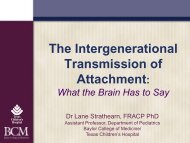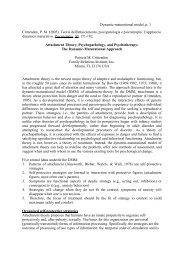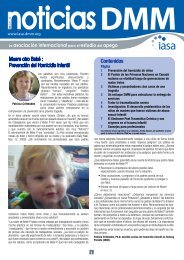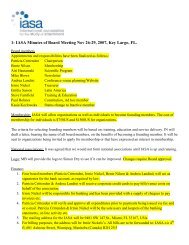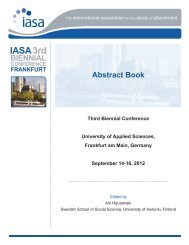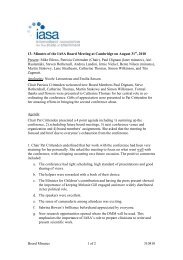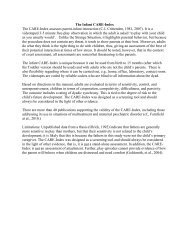The Toddler CARE-Index The Toddler CARE-Index - IASA
The Toddler CARE-Index The Toddler CARE-Index - IASA
The Toddler CARE-Index The Toddler CARE-Index - IASA
- No tags were found...
You also want an ePaper? Increase the reach of your titles
YUMPU automatically turns print PDFs into web optimized ePapers that Google loves.
<strong>The</strong> <strong>Toddler</strong> <strong>CARE</strong>-<strong>Index</strong><br />
<strong>The</strong> <strong>Toddler</strong> <strong>CARE</strong>-<strong>Index</strong> (Crittenden 2007) is an assessment of the relationship<br />
between a caregiver and child. It uses a videotaped 3-5 minute free-play observation<br />
in which the adult is asked ‘to play with your child as you usually would’. <strong>The</strong><br />
<strong>CARE</strong>-<strong>Index</strong> can be used with all attachment figures (usually parents or foster<br />
parents) and also with other adults who do not have direct care of the child.<br />
Because there is not stress to the child, it is a weaker assessment of children’s<br />
attachment than the separation and reunion measures in the Strange Situation<br />
Procedure. In cases where parents risk losing their child to state care, there is, of<br />
course, stress on the parent.<br />
In the toddler years, caregivers must manage children’s exploration and other<br />
behaviour to keep them safe; this can lead to conflict resolution which does produce<br />
attachment behaviours in the child. <strong>The</strong> <strong>Toddler</strong> <strong>CARE</strong>-<strong>Index</strong> takes account of these<br />
developmental changes in assessing the parent-child relationship. It is flexible<br />
regarding where it can be carried out; it can, for example, be conducted in the parents’<br />
home or in a clinic or even in a park.<br />
<strong>The</strong> <strong>Toddler</strong> <strong>CARE</strong>-<strong>Index</strong> is applicable to children aged from 16 months to about 72<br />
months (before 16 months the Infant version of the <strong>CARE</strong>-<strong>Index</strong> should be used). It is<br />
coded by reliable coders who are blind to the facts of the case. <strong>The</strong>re are two studies<br />
validating the toddler system (Crittenden, 1992; Künster, Fegert, & Ziegenhain,<br />
2010), but considerably more on the infant system on which it is based.<br />
<strong>The</strong> <strong>Toddler</strong> <strong>CARE</strong>-<strong>Index</strong> provides information about parents’ sensitivity, control,<br />
and unresponsiveness to children’s signals and children’s strategies for coping with<br />
parents’ behaviour. Three steps are involved: first, using the manual, seven discrete<br />
behavioural characteristics are coded: facial expression, vocal expression, position<br />
and body contact, affection, turn-taking, control, and choice of activity. <strong>The</strong>se codes<br />
are summed to yield scale scores for cooperation, compulsiveness, resistant coercion<br />
and passive coercion. <strong>The</strong>se are then converted to proxy patterns of attachment, i.e.,<br />
the DMM A, B, C, A/C patterns. <strong>The</strong> different patterns each carry a different sort of<br />
advantage and threat to the child’s development.<br />
Limitations: Unpublished data from a thesis (Olrick, 1992) indicate that fathers are<br />
generally more sensitive in play than mothers, but that their sensitivity is not related<br />
to the child’s development; it is likely that this is because the fathers in this study<br />
were not the child’s primary caregiver. <strong>The</strong> <strong>Toddler</strong> <strong>CARE</strong>-<strong>Index</strong> was designed as a<br />
screening tool and should always be considered in the light of other evidence, that is,<br />
it is not a stand-alone assessment. Further, play episodes cannot provide evidence of<br />
how the parent will behave when children are distressed and need comfort<br />
(Goldsmith, et al., 2004).
References<br />
Crittenden, P. M. (1992). Children's strategies for coping with adverse home<br />
environments. International Journal of Child Abuse and Neglect, 16, 329-343.<br />
Crittenden, P. M. (2007). <strong>CARE</strong>-<strong>Index</strong>. <strong>Toddler</strong>s. Coding Manual. Unpublished<br />
manuscript, Miami, FL, USA.<br />
Goldsmith, D., Oppenheimer, D. & Wanlass, J. (2004). Separation and reunification:<br />
Using attachment theory to inform decisions affecting the placements of<br />
children in foster care. Juvenile and Family Court Journal, Spring, 1-13.<br />
Künster , A. K., Fegert, J. M., & Ziegenhain, U. (2010). Assessing parent-child<br />
interaction in the preschool years: A pilot study on the psychometric<br />
properties of the <strong>Toddler</strong> <strong>CARE</strong>-<strong>Index</strong>. Clinical Child Psychology and<br />
Psychiatry, 15, 379-390.<br />
Olrick, J. (unpublished thesis, 1992). Maltreating fathers' internal representational<br />
models of attachment relationships, Senior Honors <strong>The</strong>sis, University of<br />
Miami, Miami, FL.



